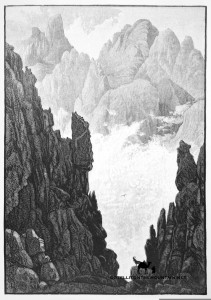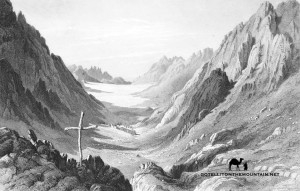Myth and legend
 The Sinai is one of the most richly fabled lands on earth: its Exodus legends have been told around the world for thousands of years and are still alive in the present. Most of us learn something about the Sinai – Moses, The Burning Bush, The Crossing of the Red Sea etc – from our early days; even if we’ve since forgotten it was ever about the Sinai. For many people, the Sinai is a place defined solely through these stories; visit today, and you’ll still find them attached to wadis, mountains; even individual rocks. But it isn’t all about legends from the Bible: the monks of the Sinai AND its Bedouin tribes have since woven their own stories into its rich tapestry. The Sinai is a place that has long made storytellers dream. Below are quick summaries of the most important ones:
The Sinai is one of the most richly fabled lands on earth: its Exodus legends have been told around the world for thousands of years and are still alive in the present. Most of us learn something about the Sinai – Moses, The Burning Bush, The Crossing of the Red Sea etc – from our early days; even if we’ve since forgotten it was ever about the Sinai. For many people, the Sinai is a place defined solely through these stories; visit today, and you’ll still find them attached to wadis, mountains; even individual rocks. But it isn’t all about legends from the Bible: the monks of the Sinai AND its Bedouin tribes have since woven their own stories into its rich tapestry. The Sinai is a place that has long made storytellers dream. Below are quick summaries of the most important ones:
THE EXODUS – This legend defines the Sinai more than any other and it goes something like this. Long ago, a people called the Israelites lived in Egypt, working as slaves under the Pharaohs. Moses was an Israelite who fled Egypt one day, after killing an Egyptian slavedriver. He lived the simple life of a mountain shepherd before God spoke to him one day from a Burning Bush, telling him to go back to Egypt and lead the Israelites out of slavery. Moses returned, gathered the Isarelites and stole away one night – as God struck down the last of the Ten Plagues – before reaching the waters of the Red Sea. It looked like there was no way ahead but, miraculously, the sea parted, allowing an escape to the Sinai. They continued up to Mount Sinai, where God gave Moses the Ten Commandments: an eternal set of laws they had to keep. Things went downhill after this as the Israelites began to question God’s plan. For their lack of faith, he condemned them to wander in the Sinai for another 40 years; hence the term The Wilderness of the Wanderings. They wandered here for the said 40 years, before the curse ended and Moses led them out of the Sinai and into the Promised Land, the so-called Land of Milk and Honey, dying an old man as it came into sight. Today, there are big doubts about the history of The Exodus. But whatever the hard history, there’s no doubting the power of the story; a people rising up against slavery and injustice before escaping to the wilderness and wandering their way to freedom.
 ST KATHERINE – St Katherine is the Sinai’s most important saint, giving her name to a monastery, a mountain and a town. Legend has it she was born into a pagan family in 3rd century Alexandria before converting to Christianity in her teens. Through hard study she became a brilliant scholar of the faith and soon spoke out against the Roman Empire’s persecution of Christians. Taken aback by the outspoken young woman, the Emperor invited her to debate with his finest court scholars: but Katherine outwitted them all, even promting some to convert to Christianity on the spot. Outraged, the Emperor threw her in jail, offering her a release only if she renounced her faith and married him. When she refused, she was sentenced to death on a contraption of rotating wheels and knives (hence the term ‘Katherine Wheel‘). In a miraculous last-minute twist, the wheel fell to pieces; but it still wasn’t enough to save her; her executioners just beheaded her instead. It’s said angels carried her body to the Sinai’s highest peak – Jebel Katherina – and laid her to rest. Monks of the Sinai say her remains stayed here until the 9th century, when they were found. Today, they’re kept in the Monastery of St Katherine and some say her bones exude a fragrant oil with special healing powers.
ST KATHERINE – St Katherine is the Sinai’s most important saint, giving her name to a monastery, a mountain and a town. Legend has it she was born into a pagan family in 3rd century Alexandria before converting to Christianity in her teens. Through hard study she became a brilliant scholar of the faith and soon spoke out against the Roman Empire’s persecution of Christians. Taken aback by the outspoken young woman, the Emperor invited her to debate with his finest court scholars: but Katherine outwitted them all, even promting some to convert to Christianity on the spot. Outraged, the Emperor threw her in jail, offering her a release only if she renounced her faith and married him. When she refused, she was sentenced to death on a contraption of rotating wheels and knives (hence the term ‘Katherine Wheel‘). In a miraculous last-minute twist, the wheel fell to pieces; but it still wasn’t enough to save her; her executioners just beheaded her instead. It’s said angels carried her body to the Sinai’s highest peak – Jebel Katherina – and laid her to rest. Monks of the Sinai say her remains stayed here until the 9th century, when they were found. Today, they’re kept in the Monastery of St Katherine and some say her bones exude a fragrant oil with special healing powers.
 BEDOUIN LEGENDS – Bedouin legends enrich the Sinai’s landscapes as much as Biblical ones. As an oral people, stories and poems have long been at the heart of Bedouin culture. They told them every night around the fire and there are fables about everything from evil, desrt-dwelling ghouls to the ghosts of benevolent Sheikhs and immortal maidens who lived on mountain tops, enchanting people with their beautiful song. Some legends were inspired by real-life stories too: one of the most famous is about two Bedouin sisters who ran away and jumped to their deaths from a high mountain in Wadi Feiran – Jebel Banat or Mountain of the Girls – in an act of rebellion against their father’s plans to marry them to men they didn’t love. Today, the Bedouin oral tradition is in decline and many stories have been forgotten or are in the process of being forgotten. Even so, you can still find them recorded in the writings of early travellers or by asking older Bedouin of the peninsula, some of whom are trying to write them down before they’re gone for good.
BEDOUIN LEGENDS – Bedouin legends enrich the Sinai’s landscapes as much as Biblical ones. As an oral people, stories and poems have long been at the heart of Bedouin culture. They told them every night around the fire and there are fables about everything from evil, desrt-dwelling ghouls to the ghosts of benevolent Sheikhs and immortal maidens who lived on mountain tops, enchanting people with their beautiful song. Some legends were inspired by real-life stories too: one of the most famous is about two Bedouin sisters who ran away and jumped to their deaths from a high mountain in Wadi Feiran – Jebel Banat or Mountain of the Girls – in an act of rebellion against their father’s plans to marry them to men they didn’t love. Today, the Bedouin oral tradition is in decline and many stories have been forgotten or are in the process of being forgotten. Even so, you can still find them recorded in the writings of early travellers or by asking older Bedouin of the peninsula, some of whom are trying to write them down before they’re gone for good.